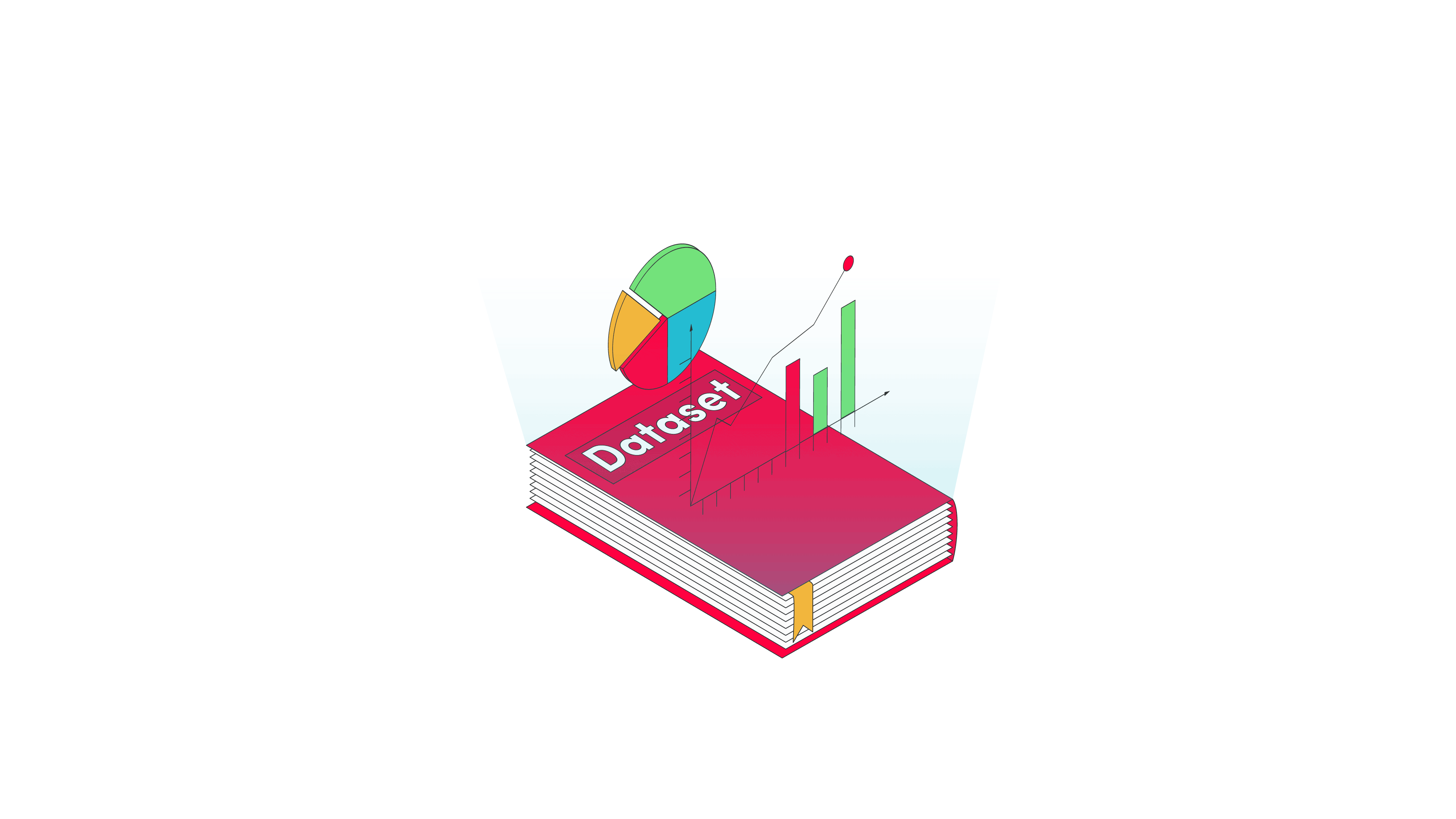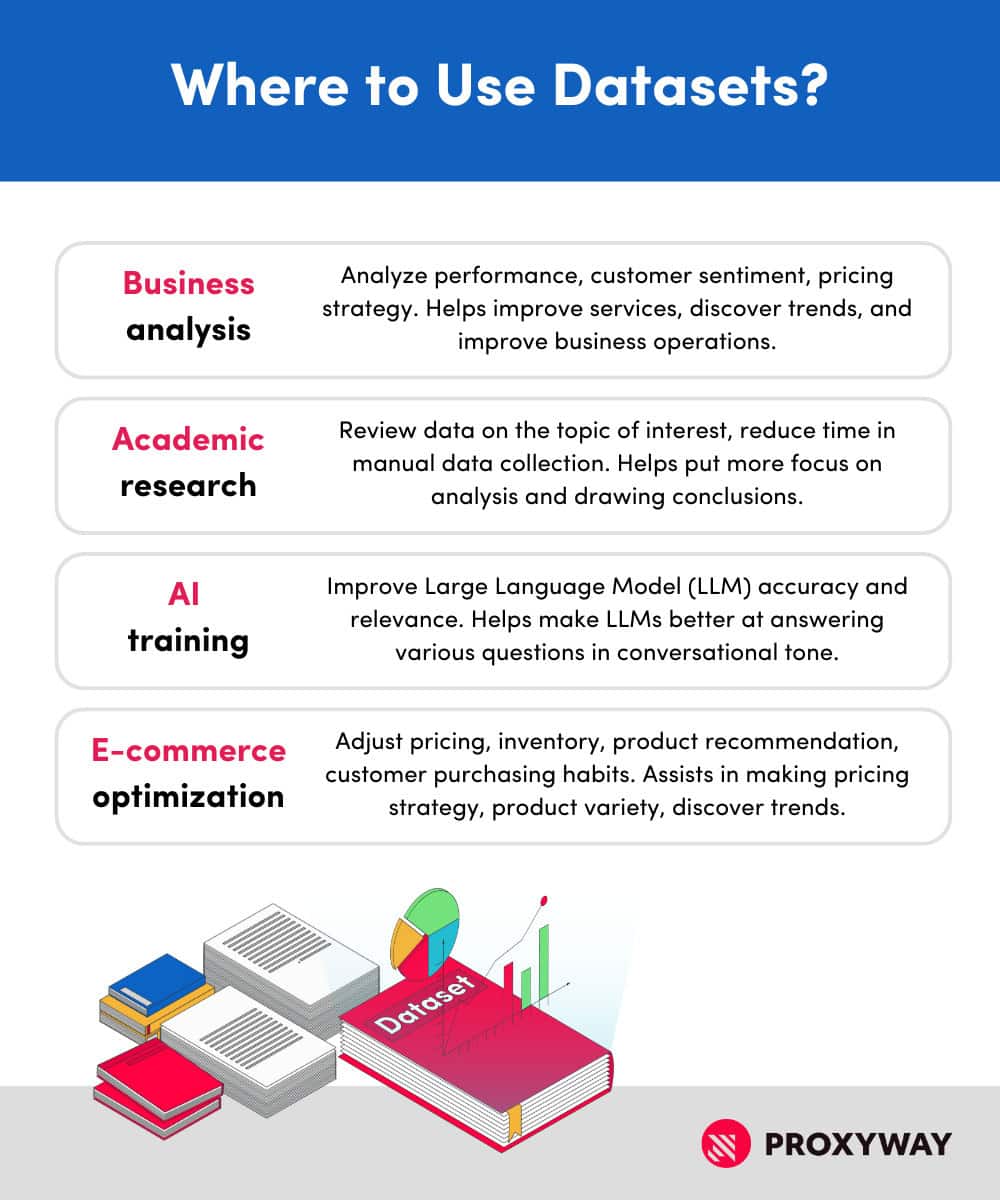What Is a Dataset? Comparing Scraping APIs and Pre-Collected Datasets
The world runs on data, but it’s not always easy to find it. However, datasets offer an easy way to access large volumes of structured data on essentially any topic.

Web scraping tools allow you to gather vast volumes of data in seconds. But with more companies offering data-as-a-service (DaaS), you don’t even have to collect information yourself. Instead, you can get pre-collected datasets from basically any website, and jump straight to analysis.
But what exactly are datasets, and why do they matter? Essentially, a dataset is a collection of structured records on a specific topic for further processing. It allows easy access to information about various fields, topics, and subjects. Since datasets typically are huge collections of information, they make research more accessible and fast. In this article, let’s dig deeper into what datasets are, how they are made, and where to use them.
What Are Datasets?
Datasets are collections of records about a specific topic. It’s a static compilation of important data points that can vary from weather forecast to product prices. The key attribute of a dataset is its structure – it is organized (often arranged in a table) and prepared for further analysis.
There are numerous ways to use datasets, both for research and business management purposes, such as marketing and social media management, or tracking and analyzing e-commerce data. Datasets can also be valuable for recruitment purposes.
Types of Datasets
There are many types, forms, and structures of datasets. The type of dataset you should get depends on what sort of analysis you’re planning to perform (i.e., qualitative, quantitative).
Firstly, datasets can be broken down into several types:
- Numerical datasets consist of numbers only. They’re mostly used for quantitative analysis for statistics or mathematics. For example, such data includes stock prices, temperature records, or order values.
| Date | Temperature (°C) | Wind speed (km/h) |
| 2025-01-01 | 7.3 | 8 |
| 2025-01-02 | 8.1 | 12 |
| 2025-01-03 | 6.9 | 11 |
- Textual datasets are composed of written information, and they’re ideal for qualitative analysis. For example, textual datasets can be a collection of X posts (previously known as tweets), press releases, customer feedback, or research papers.
[
"Great quality and fast shipping!",
"The product broke after a week. Very disappointed.",
"Affordable and works as described. Will buy again."
]
- Multimedia datasets include audio, video, and image data. They can be used for both quantitative and qualitative analysis.
| Image file | Label |
| Monitor | |
| Server | |
| Sneakers |
- Time-series datasets contain data collected periodically. For example, price changes on a monthly basis or daily weather reports.
| Timestamp | Stock price ($) | Volume |
| 2025-01-01 09:00 | 150.25 | 500,000 |
| 2025-01-01 09:15 | 155. 30 | 525,000 |
| 2025-01-01 09:30 | 151.75 | 510,000 |
- Mixed datasets combine different types of data – textual, numerical, multimedia. They are especially useful for multi-faceted reports, like customer sentiment or customer behavior analyses.
| Image ID | Description | Image file | Author |
| 101 | “Red proxy server icon” |
| Isabel |
| 102 | “Yellow globe icon” | Adam | |
| 103 | “Blue scraper icon” |  | Chris |
Secondly, datasets can have varying organization structures:
- Structured datasets have organized rows and columns containing specific data points. For example, a structured dataset can be an Excel sheet or a CSV file containing data.
- Unstructured datasets don’t have a predefined format due to the type of data they contain (audio, images, text). They might be more difficult to analyze due to their unorganized nature.
However, if you’re looking to purchase a dataset, you’ll most likely encounter mixed datasets as they allow for various potential analyses.
Dataset Examples
Now that you know the different types of datasets, let’s take a better look at how they can look like.
Below is an example of a mixed dataset in a structured table. The datapoints vary – you can see text and numbers, yet they are neatly organized within the table. Each element includes several data points, and is arranged in an ascending order.
Product ID | Name | Price | Category |
101 | Scraping robot | $49 | Scrapers |
102 | Computer monitor | $139 | Electronics |
103 | Proxy server | $2000 | Hardware |
104 | Mobile phone | $250 | Electronics |
Let’s analyze another table below, it might look like an ordered time-series dataset – an organized table with numeric data points about the weather. However, if you take a closer look, you’ll notice the timestamps don’t really have any logical order. This makes it an unstructured time-series dataset.
Timestamp | Temperature (°C) | Humidity (%) |
2024-12-26 14:00:00 | 13.0 | 45 |
2024-12-27 12:00:00 | 7.4 | 79 |
2024-12-25 14:00:00 | 10.2 | 56 |
Both of these datasets can be used for making analyses or training AI, but they will have different applications.
Why Use Datasets?
Datasets are an invaluable tool for various niches, ranging from business to research. For example, companies can adjust pricing strategies due to price changes in competition, improve services by uncovering customer behavior patterns, make future plans by monitoring trends, and more.
In academia, datasets can help save time in collecting and structuring data. A pre-made dataset reduces the time needed for manually collecting specific data points, and thus allows for more focus on data analysis and drawing conclusions. Additionally, having more data points allows for data validation by improving statistical significance and capturing data variability.
Finally, datasets can also be used to train AI. Large language models (LLMs) rely on vast volumes of data so they can provide you with detailed answers in a conversational tone. However, if you ever used AI-based tools like Open AI’s ChatGPT or Google’s Gemini, you might have noticed that the answers are not always correct. Providing AI with a collection of fresh data can help the LLM improve accuracy.

Dataset vs Database
While we covered what a dataset is, you might’ve encountered another term – database – when talking about a collection of information. So, how do these terms differ?
A database is a dynamic collection of stored data. It’s a digital library where information is stored, can be quickly found, managed, reorganized, or completely changed. Maintaining a database requires specific software and hardware.
We can think of a database as being similar to the Contacts app on your phone. The app holds names, phone numbers, and other information about people in your life. You can adjust this data immediately if someone’s name or phone number changes. The app is a specific software that lets you access and manage phone numbers, and your phone’s processor, memory, and storage allow the app to run smoothly.
However, if you decide to print the phone numbers from your Contacts app on a sheet of paper, it becomes a dataset – a static snapshot of data. You can analyze it (i.g., check how many people named John you know), but it cannot be edited, deleted, or otherwise manipulated. It simply reflects the data from the app at a specific point in time.
Both datasets and databases hold information, but as you can see in the example, the database (the Contacts app) is dynamic – information can be accessed, managed, and changed. On the other hand, datasets are static (the printed contacts) – they reflect the current information that exists. If the information in the database is updated, you’ll have to create a new dataset to reflect these changes.
How are Datasets Created?
In order to understand datasets better, it’s important to know how they are made. There are a few ways to collect information for datasets:
- Web scraping. It’s a more modern way to extract relevant data from online sources using custom-built or third-party web scraping tools.
- Using existing databases. Use existing public or private (with permission) databases, like government data portals, IMDb, or weather forecast websites to collect structured data.
- Recording data manually. Manually write down observations, like writing down numbers or descriptions, and conduct surveys.
- Combining sources. Merge all your data to create a well-rounded dataset on a specific topic. The more sources you use, the more reliable and accurate your dataset will be.
Depending on the type of dataset you need for your research project, you can either create it yourself or purchase a pre-made one from dataset vendors. Some providers that offer web scraping tools also have pre-collected datasets that are regularly updated to minimize the need for manual data collection.
Web Scraping vs. Pre-built Datasets
It would be very difficult to create modern, up-to-date datasets without scraping the web. Manual data collection takes a lot of time, especially when collecting information online since there’s so much of it.
Instead, web scrapers offer an option to collect, clean, and structure web data automatically. However, choosing between datasets and web scrapers depends on the nature of your project.
When to Choose Web Scraping?
Web scraping is a method of automatically collecting data from the web using a specific software. Web scraping tools – self-made or third-party scraping APIs – can help gather large volumes of data from the selected sites much quicker, compared to manual collection, but that’s not the only benefit they offer. They also often parse (clean) and structure data for better readability, so there’s less need for processing information yourself.
However, customizing a web scraper and extracting data can be a hassle. If you’re planning to do it often, you’ll need to run the tool each time you need to collect fresh information, and adjust it every time something in the website’s structure changes. If you use a self-made scraper, you’ll also have to invest into its maintenance.
Alternatively, you can purchase pre-made web scrapers to avoid taking care of the tool’s infrastructure, but they can get expensive, especially with larger projects.
Web scraping is ideal for time-sensitive use cases, such as tracking e-commerce statistics (pricing, product availability, etc.), extracting social media, travel, real estate data, or collecting the latest news.
When to Choose Datasets?
While datasets are an incredibly valuable and time-saving tool, they come with their own set of limitations. Notably, their freshness and accuracy to your project.
Firstly, pre-built datasets might not have the specific information you’re looking for. It’s rare for dataset vendors to give customers a peek into what information such datasets contain. Therefore, there’s a risk that the data will be only partially or completely unusable for your specific case. Additionally, datasets can become stale, especially if you need time-sensitive data.
Additionally, you can’t always customize a dataset. By purchasing a pre-made one, you can’t ask for specific information to be included as the datasets are made for the general audience. In this case, choosing a scraping API is much better.
Therefore, where data freshness isn’t the highest priority – analyzing historical e-commerce data, AI training, researching the market demographic, sales, & customer behavior – use datasets.
Datasets and Scraping APIs: Data Delivery Methods
Datasets are static, though periodically updated collections of data. Typically, they are downloaded and stored for offline use. Most often, you’ll find datasets in formats like CSV, JSON, or Excel, so they provide a clear, organized snapshot of information.
This makes datasets ideal for tasks like data analysis, machine learning model training, or accessing archival information where real-time updates are not critical.
Scraping APIs, on the other hand, deliver data on-demand, providing real-time access to information. Unlike datasets, APIs offer the ability to fetch specific pieces of data. They are ideal for cases requiring up-to-date information, such as stock prices, weather updates, or social media feeds.
Datasets | Scraping APIs | |
Data access | Provides a snapshot of data from a specific time | On-demand access to specific data |
Delivery frequency | One-time download, can be updated at selected frequency (weekly, monthly, quarterly) | Real-time or on-demand |
Data format | JSON, CSV, Excel, SQL, and other structured formats | Raw HTML, CSV, JSON |
Performance | Not affected by network; works offline | Depends on server uptime, network latency |
Cost | One-time payment | Subscription- or API credit-based; depends on traffic or requests |
Conclusion
Datasets, especially pre-made ones, are becoming an integral part of data-driven decision-making. Valuable for dozens of fields, up-to-date datasets are essential for businesses as well as academia, as they help access loads of data in a readable, structured way.

